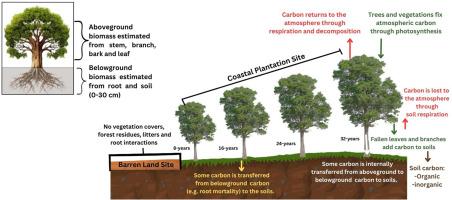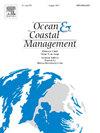Ecosystem carbon accumulation of Sonneratia apetala mangroves along an afforestation chronology in Bangladesh
IF 4.8
2区 环境科学与生态学
Q1 OCEANOGRAPHY
引用次数: 0
Abstract
Coastal plantation ecosystems play a vital role in the protection of coastal regions, biodiversity conservation, and the provision of valuable ecosystem services. These ecosystems have been recognized for their capacity to sequester carbon, making them instrumental in mitigating global warming. In this study, we assessed ecosystem carbon (EC) density levels in Sonneratia apetala planted coastal ecosystems in the Char Kukri-Mukri and Montaz mangrove reserves in the south-central Bangladesh. Using 48 representative plots from four stand ages (8–32 years), carbon density changes in trees and soil (0–15 and 15–30 cm) were evaluated. Results showed significant differences in vegetation carbon (VC) density, soil organic carbon (SOC) concentration, SOC density, and EC density among different stand ages, soil depths and mangroves. The increased EC density in Char Kukri Mukri (12.21 t ha−1 yr−1) and in Char Montaj (12.62 t ha−1 yr−1) with advancing stand ages (year-8 to year-32) provides empirical evidence of the effectiveness of afforestation in enhancing EC density in S. apetala planted mangroves. Regardless of stand age, the higher SOC density found in the upper soil layer (51 t ha−1 in year-32 stand) compared to the lower layer (38 t ha−1 in year-32 stand) in both mangroves highlights that the majority of soil carbon is concentrated in the top 15 cm of the forest floor. Within the 0–30 cm soil layer, SOC density demonstrated an increasing trend, with rates of 1.30 t ha−1 yr−1 in Char Montaj, and 1.33 t ha−1 yr−1 in Char Kukri Mukri mangroves between year-8 and year-32 stands. This study provides valuable insights for policymakers, land managers, and conservation practitioners, emphasizing the significance of coastal plantation ecosystems in carbon sequestration and the need for informed management strategies to optimize their climate mitigation potential.

孟加拉国 Sonneratia apetala 红树林生态系统碳积累的植树造林年表
沿海种植园生态系统在保护沿海地区、保护生物多样性和提供宝贵的生态系统服务方面发挥着至关重要的作用。这些生态系统的固碳能力已得到认可,使其在减缓全球变暖方面发挥了重要作用。在这项研究中,我们评估了孟加拉国中南部 Char Kukri-Mukri 和 Montaz 红树林保护区内种植的 Sonneratia apetala 沿海生态系统的生态系统碳密度水平。利用四个林龄(8-32 年)的 48 个代表性地块,对树木和土壤(0-15 厘米和 15-30 厘米)中的碳密度变化进行了评估。结果表明,不同树龄、土壤深度和红树林的植被碳密度、土壤有机碳浓度、土壤有机碳密度和导电率密度存在明显差异。Char Kukri Mukri(12.21 吨/公顷-年-1)和 Char Montaj(12.62 吨/公顷-年-1)的导电率密度随着林龄(第 8 年至第 32 年)的增加而增加,这为植树造林有效提高 S. apetala 种植红树林的导电率密度提供了实证证据。无论林分年龄如何,两种红树林土壤上层的 SOC 密度(第 32 年林分的 51 吨/公顷-1)均高于下层(第 32 年林分的 38 吨/公顷-1),这说明土壤碳大部分集中在林地顶部 15 厘米处。在 0-30 厘米土层中,SOC 密度呈上升趋势,在 Char Montaj 和 Char Kukri Mukri 红树林中,在第 8 年和第 32 年之间,SOC 密度分别为 1.30 吨/公顷-年和 1.33 吨/公顷-年。这项研究为政策制定者、土地管理者和保护工作者提供了宝贵的见解,强调了沿海种植园生态系统在固碳方面的重要性,以及制定明智的管理策略以优化其气候减缓潜力的必要性。
本文章由计算机程序翻译,如有差异,请以英文原文为准。
求助全文
约1分钟内获得全文
求助全文
来源期刊

Ocean & Coastal Management
环境科学-海洋学
CiteScore
8.50
自引率
15.20%
发文量
321
审稿时长
60 days
期刊介绍:
Ocean & Coastal Management is the leading international journal dedicated to the study of all aspects of ocean and coastal management from the global to local levels.
We publish rigorously peer-reviewed manuscripts from all disciplines, and inter-/trans-disciplinary and co-designed research, but all submissions must make clear the relevance to management and/or governance issues relevant to the sustainable development and conservation of oceans and coasts.
Comparative studies (from sub-national to trans-national cases, and other management / policy arenas) are encouraged, as are studies that critically assess current management practices and governance approaches. Submissions involving robust analysis, development of theory, and improvement of management practice are especially welcome.
 求助内容:
求助内容: 应助结果提醒方式:
应助结果提醒方式:


